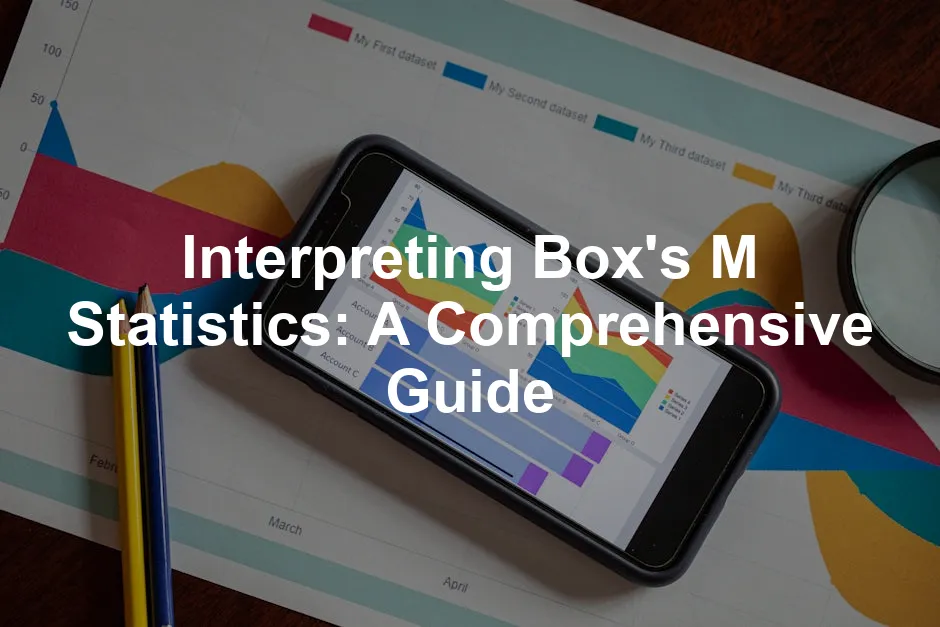Introduction
Box’s M test plays a pivotal role in multivariate statistics. It checks if multiple variance-covariance matrices are equal. Why is this important? Because it helps validate assumptions in Analysis of Variance (ANOVA) and its multivariate cousin, MANOVA. Imagine conducting research but forgetting to check the foundational assumptions. Yikes! Your results could be as reliable as a chocolate teapot.
In this article, we’ll unpack the nuances of interpreting Box’s M statistics. You’ll learn about its applications, key assumptions, limitations, and how it stacks up against other tests. Whether you’re a seasoned researcher or a curious newbie, understanding Box’s M is crucial. It’s not just a number; it’s a gateway to ensuring your analyses are sound.
Why should you care? If you’re in fields like psychology, ecology, or social sciences, Box’s M can be your best friend. It helps ensure that the conclusions you draw from your data are valid, making your research credible and impactful. So, grab your favorite beverage and let’s dive into the fascinating world of Box’s M!

Understanding Box’s M Test
What is Box’s M Test?
Box’s M test, formally known as Box’s Test for Equivalence of Covariance Matrices, is a parametric test. It evaluates whether the covariance matrices for multiple groups are equal. Think of it as the referee in a match between groups—it decides if they’re all playing on an equal field.
This test was introduced by the legendary George E. P. Box in 1949. He recognized the need for a statistical method to assess assumptions crucial to multivariate analyses. Box’s M test has since become a staple in the statistical toolkit, especially for researchers tackling complex datasets.
Applications of Box’s M Test
When should you reach for Box’s M? Primarily, it’s used in MANOVA and linear discriminant analysis. If your research involves multiple dependent variables and you need to compare groups, this test is your go-to. It’s like checking the oil before a road trip. You wouldn’t want to hit the highway without ensuring everything is running smoothly!
Box’s M is particularly useful when you have unequal sample sizes across groups. It examines the equality of covariance matrices, ensuring that your analysis isn’t skewed by disproportionate variances. Imagine that you’re studying the effect of different teaching methods on student performance. If one group has way more students than another, Box’s M helps you determine if that imbalance affects your results.
In summary, Box’s M test is vital for researchers aiming to validate their findings. It’s the unsung hero that makes sure that your statistical engine runs without a hitch. So, the next time you plan a study involving multiple groups, don’t forget to check for homogeneity with Box’s M!

Assumptions and Limitations
Key Assumptions of Box’s M Test
Multivariate Normality
For Box’s M test to strut its stuff, your data must be multivariate normally distributed. Picture this: your dependent variables should each follow a bell-shaped curve, while also being correlated with one another. If they don’t, the test might throw a tantrum and produce unreliable results.
Why does this matter? Well, when the assumptions of normality are violated, Box’s M becomes sensitive. This means it could incorrectly signal that your covariance matrices are unequal, leading you down a rabbit hole of misinterpretation. So, unless you’ve got your data dancing to the tune of multivariate normality, it’s best to reconsider using Box’s M.
Homogeneity of Covariance Matrices
Next up, we have the homogeneity of covariance matrices. This assumption demands that the variance-covariance matrices for all groups are equal. Think of it like a tightly-knit group of friends who all share equal amounts of popcorn during movie night. If one friend hogs all the snacks, the balance is off, and so is your analysis.
Ensuring this homogeneity is crucial because if the matrices are not equal, your test results can become skewed. In essence, Box’s M checks if every group is playing fair. If it finds that one group is a popcorn hog, the test results may indicate significant discrepancies, putting your overall findings into question.
Limitations of Box’s M Test
Sensitivity Issues
Box’s M test isn’t without its quirks. It can be overly sensitive to deviations from normality. If your data throws a wild party instead of following the normal distribution, the test might just give up and return unreliable results. This sensitivity means that even minor violations can lead to major misinterpretations.
Moreover, sample size plays a big role here. In small samples, Box’s M lacks power, which is a fancy way of saying it might fail to detect actual differences when they exist. If you get a non-significant result from a small sample, it doesn’t mean your groups are equal. It just might be that the test didn’t have enough “muscle” to detect the differences.
Power Concerns
When it comes to power, Box’s M has different strengths depending on sample size. Cohen (2008) and Hahs-Vaughn (2016) highlight that larger samples can sometimes yield significant results, even when there isn’t a real effect. This can create a false sense of confidence, as the test might detect differences that aren’t practically meaningful. So, when interpreting your results, be cautious—just because the test says “yes” doesn’t mean it’s shouting with certainty.
Alternative Tests
If Box’s M isn’t cutting it for your data, don’t fret! There are alternatives. Levene’s test is a popular choice for checking equality of variances, especially when your data isn’t normally distributed. It’s like inviting a reliable friend who doesn’t mind if there’s a bit of chaos in the room.
Another option is Bartlett’s test, which works best with normally distributed data. While Box’s M focuses on covariance matrices, Levene’s and Bartlett’s tests hone in on variance. If you find your data straying from the normal path, it’s wise to consider these alternatives.
In conclusion, grasping the assumptions and limitations of Box’s M test is essential for any researcher. Understanding these factors ensures that your statistical analyses remain robust, reliable, and ready to impress.

Performing Box’s M Test
Step-by-Step Guide
Data Preparation
Before conducting Box’s M test, your data must be primed and ready. First, ensure that your dataset includes multiple groups with dependent variables that you want to analyze. Each group should have a sufficient number of observations—think of it as making sure everyone shows up for the party!
Next, check for multivariate normality. This means your dependent variables should follow a bell curve and be correlated. If your data is more like a rollercoaster than a smooth ride, consider transformations to achieve normality. Outliers? They can be party crashers, so identify and handle them accordingly. Group sizes matter too! Unequal sizes can affect the results, so try to balance them as best you can.
Finally, ensure that the dependent variables are measured on a continuous scale. If your variables are categorical, Box’s M is not your friend.

Statistical Software
Now, let’s get to the fun part: running the test! You can use SPSS or R to perform Box’s M test. We’ll break it down for both.
In SPSS:
- Load your dataset.
- Click on “Analyze,” then navigate to “General Linear Model,” and select “Multivariate.”
- Move your dependent variables into the “Dependent Variables” box.
- Move your grouping variable into the “Fixed Factor(s)” box.
- Click on “Options” and check the box for “Homogeneity tests.”
- Hit “OK” and watch the magic happen! Review the output for Box’s M statistic, chi-squared values, degrees of freedom, and p-values.
In R:
- Load your data into R and ensure it’s in a proper format.
- Use the
boxM()function from theheplotspackage. Here’s a sample code to get you started:
library(heplots)
boxM(Y ~ group, data = mydata)- Replace
Ywith your dependent variables andgroupwith your grouping variable. - Run the code and check the output for the chi-squared statistic and p-value.
With either software, you’ll get a detailed output to interpret and analyze.

Interpreting Results
Understanding Output
Once you’ve conducted Box’s M test, it’s time to interpret the results. Look for the chi-squared statistic, degrees of freedom (df), and the p-value.
The chi-squared value tells you how far the observed covariance matrices deviate from the expected ones. Think of it as a scorecard in a game—higher values indicate a larger difference between groups.
Degrees of freedom help contextualize this score. Generally, df equals the number of groups minus one. A higher degree of freedom means more data points are giving you statistical power.
The p-value is your golden ticket. It helps you determine if the results are statistically significant. If your p-value is less than 0.05, it suggests that at least one group has a different covariance structure. If it’s below 0.001, then the differences are highly significant.

Significance Levels
Understanding p-values can feel like a maze, but let’s break it down. A p-value under 0.05 suggests that you can reject the null hypothesis, meaning at least one group’s covariance matrix differs from the others. If your p-value dips below 0.001, that’s like winning the jackpot! It indicates robust evidence against the null hypothesis.
But what if your p-value is greater than 0.05? It doesn’t mean your groups are identical; rather, you lack sufficient evidence to claim a difference. Always consider the context of your research and the potential implications of these findings.
Examples of Box’s M Results
Case Studies
Case Study 1: Education Research
Let’s say researchers are examining the effect of different teaching methods across three schools. They collect data on student performance in mathematics, science, and language arts. After running Box’s M test, the results show a chi-squared value of 30.45 with 6 df and a p-value of 0.002. What does this mean? The significant p-value indicates that at least one school has a different variance-covariance structure in student performance, prompting further investigation into which teaching method works best.
Case Study 2: Ecological Study
In another scenario, ecologists are studying the impact of fertilizer types on plant growth across four different environments. Box’s M test yields a chi-squared value of 18.22, with 9 df and a p-value of 0.045. Here, the significant result implies that the variance in plant growth due to different fertilizers varies across environments. This finding could lead to targeted recommendations for fertilizer use based on specific ecological conditions.
These examples illustrate how Box’s M test can provide crucial insights into the effects of different factors on your dependent variables. Understanding and interpreting the results can guide future research and practical applications in various fields.

Comparisons with Other Tests
Box’s M vs. Other Tests
Bartlett’s Test
Bartlett’s test is the classic choice for checking the equality of variances, especially when your data meets the assumptions of normality. While Box’s M focuses on covariance matrices across multiple groups, Bartlett’s test hones in on variances. Think of it as the test that checks if the popcorn bags are evenly filled before movie night.
However, Bartlett’s test has a notable flaw: it’s sensitive to violations of normality. If your data isn’t normally distributed, Bartlett’s can produce misleading results. In contrast, Box’s M takes a broader view, examining covariance matrices rather than just variances. This makes Box’s M more robust when dealing with irregular data distributions.
In summary, if you’re working with normally distributed data, Bartlett’s test is a reliable choice. But if there’s a hint of non-normality, consider Box’s M as your trusty sidekick.

Levene’s Test
Now, let’s talk about Levene’s test. This test is like the cool kid who doesn’t care about normality. It’s designed to check the equality of variances, making it ideal for datasets that don’t follow a normal distribution. Levene’s test is particularly useful because it assesses how spread out the data is, regardless of its shape.
If your data is irregular, Levene’s test can save the day. It offers a more accurate picture of variance equality across groups. On the flip side, Box’s M test might give you a more comprehensive understanding of covariance structures, which can be vital in multivariate analyses.
In summary, if your data is non-normal, Levene’s test is the way to go. It’s like having a versatile friend who fits in anywhere, while Box’s M excels when you need to examine covariance matrices in detail.
When to Choose Which Test
Choosing the appropriate test can feel like navigating a maze. Here are some handy guidelines to help you select the right statistical tool based on your data characteristics:
- Data Distribution: If your data is normally distributed, Bartlett’s test is a solid choice. If normality is in question, turn to Levene’s test.
- Focus of Analysis: If you need to compare variances only, Bartlett’s or Levene’s will do the trick. But if you’re diving into multivariate analyses and want to check covariance matrices, Box’s M is your best bet.
- Sample Size: Smaller samples can be tricky. Use Levene’s test if you suspect unequal variances, as it’s less sensitive to sample size. For larger samples, Box’s M can be reliable, provided the underlying assumptions hold true.
- Research Field: Consider the norms in your field. In psychology, for example, researchers often prefer Box’s M for its robustness in multivariate analyses. In contrast, in fields like ecology, Levene’s test might be more commonly used due to the non-normal nature of certain datasets.
By keeping these guidelines in mind, you can make informed decisions about which test to use. Remember, the choice of test can significantly influence your findings, so choose wisely!

Practical Applications and Considerations
Real-World Applications
Psychology
In psychology, researchers frequently use Box’s M test while studying the effects of different therapeutic approaches on a range of psychological outcomes. For instance, a study may compare cognitive behavioral therapy and traditional talk therapy across multiple outcome measures like anxiety levels, depression scores, and overall well-being. By validating the homogeneity of covariance matrices, researchers can ensure their MANOVA results are reliable and meaningful. If you’re looking to dive deeper into statistics, consider picking up Statistical Methods for Psychology to enhance your understanding and application of these concepts!

Ecology
In the realm of ecology, Box’s M test is invaluable when assessing how different environmental factors influence biodiversity across multiple species. Imagine studying the impact of varying land-use practices on species richness and abundance. A Box’s M test can confirm that the variance-covariance structures are similar across different land-use types, ensuring that subsequent analyses accurately reflect the ecological dynamics at play. To further your ecological research, check out The Art of Statistics: Learning from Data for a solid foundation!
Social Sciences
In social sciences, researchers often analyze the effects of socio-economic factors on educational outcomes. For example, a study might assess how family income and parental education levels impact students’ performance across subjects like math, science, and language arts. Box’s M test allows researchers to verify that the covariance matrices across these different educational measures are comparable, thus bolstering the credibility of their findings. Want to understand more about data analysis in social contexts? Grab Data Analysis for Social Science: A Friendly and Practical Introduction!

Implications for Research
Understanding Box’s M results can have profound implications for research conclusions. If Box’s M indicates significant differences in covariance structures, researchers must tread carefully. This could suggest that the assumptions underpinning their analyses are violated, leading to potentially erroneous conclusions.
For example, if a researcher studying the effectiveness of a new teaching method finds significant results but fails to account for unequal covariance matrices, they may mistakenly attribute improvements in student performance to the teaching method rather than underlying group differences. This highlights the importance of interpreting Box’s M results in the context of the broader research framework.
In conclusion, Box’s M test plays a crucial role in various fields, ensuring that analyses are grounded in solid statistical foundations. By understanding its applications and implications, researchers can enhance the reliability and validity of their findings, ultimately contributing to better-informed decisions in their respective fields.

Common Mistakes to Avoid
Misinterpretation of Results
Interpreting Box’s M test results can be a slippery slope. One of the most common mistakes is confusing the test’s significance with the actual equality of covariance matrices. Just because the p-value is high doesn’t mean your groups are identical. It simply suggests a lack of evidence against the null hypothesis.
Another pitfall? Ignoring the effect of sample size. Smaller samples may lead to unreliable results. A non-significant Box’s M in a tiny sample doesn’t guarantee that your covariance matrices are equal. Always consider the sample size when interpreting results. And remember, a significant result doesn’t always scream, “Aha! This is meaningful!” Context matters.
To avoid these mishaps, ensure you understand the implications of the test statistic. Review the chi-squared value alongside the p-value. They tell different stories, and both are vital for drawing accurate conclusions. A little caution goes a long way in ensuring your interpretations are spot on.
Neglecting Assumptions
Before you hit the “run” button on Box’s M test, take a moment to check your assumptions. This test is highly sensitive to violations, particularly the assumption of multivariate normality. If your data isn’t dancing to the normal distribution tune, the results could lead you astray.
Moreover, homogeneity of covariance matrices must hold true. If your groups are behaving like cats at a dog show—chaotic and vastly different—then Box’s M might not be the right fit. Always check these assumptions first. Utilizing visualizations like Q-Q plots can provide insights into your data’s distribution.
If you find that your data violates these assumptions, consider alternative tests. Levene’s test, for example, is less sensitive to normality violations and can serve as a reliable backup. Always ensure your data meets the necessary criteria before proceeding with Box’s M to avoid disastrous consequences in your analysis.

Conclusion
Box’s M test is a cornerstone for researchers dealing with multivariate data. Its primary role? To assess the equality of variance-covariance matrices across groups. This is crucial for ensuring that assumptions in analyses like MANOVA hold true. If Box’s M indicates homogeneity, you can confidently move forward with your analyses, knowing your results are built on solid ground.
However, misinterpretation can lead to flawed conclusions. A significant result doesn’t always mean you’re in the clear. Contextualize your findings and consider sample sizes. Understanding the nuances of Box’s M is not just a technical requirement; it’s essential for drawing valid conclusions in your research.
As you apply Box’s M in your studies, remember to double-check your assumptions. This will prevent you from unwittingly stepping into the quagmire of erroneous interpretations. So, embrace this test and use it wisely! It can greatly enhance the reliability of your statistical analyses.
In the end, understanding and interpreting Box’s M statistics can elevate your research. Whether you’re in psychology, ecology, or social sciences, this knowledge equips you to validate your findings and contribute meaningful insights to your field. So, roll up your sleeves and dive into your data with confidence!
FAQs
Frequently Asked Questions
What do I do if my data violates the assumptions of Box’s M?
If your data doesn’t meet Box’s M assumptions, don’t panic! Consider using Levene’s test or Bartlett’s test as alternatives. These tests can help assess homogeneity of variances, especially in non-normal datasets. Additionally, applying transformations to your data or using non-parametric tests can also provide valuable insights while circumventing the limitations of Box’s M.
How do I report Box’s M results in my research paper?
When reporting Box’s M results, be transparent. Include the Box’s M statistic, degrees of freedom, and p-value in your results section. A clear interpretation of what these values imply regarding your hypotheses is crucial. For example, you might say, “The Box’s M test indicated a significant difference in covariance matrices, X²(21) = 28.033, p = 0.01, suggesting that at least one group has different variance characteristics.”
Are there any software tools that can help with Box’s M Test?
Absolutely! Popular statistical software like SPSS, R, and SAS have built-in functions for conducting Box’s M test. In SPSS, you can find it under the “Multivariate” options. For R, the `heplots` package includes a function specifically for Box’s M. Additionally, JASP provides a user-friendly interface for performing this test without the need for coding.
Understanding the emerging trends in statistical analysis can greatly enhance your research methodologies.
If you’re looking to add some modern flair to your home office while analyzing data, consider investing in a Ergonomic Office Chair to keep you comfortable during those long data analysis sessions!
Please let us know what you think about our content by leaving a comment down below!
Thank you for reading till here 🙂
All images from Pexels




